Click on images to enlarge
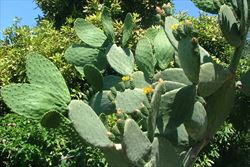
habit (Photo: Sheldon Navie)
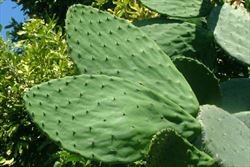
spineless stem segments (Photo: Sheldon Navie)

flower and immature fruit (Photo: Sheldon Navie)
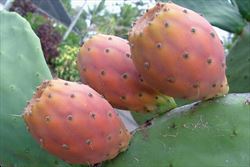
close-up of mature fruit (Photo: Sheldon Navie)
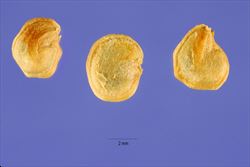
close-up of seeds (Photo: Steve Hurst at USDA PLANTS Database)
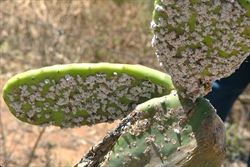
stem segments damaged by the prickly pear cochineal biocontrol agent (Photo: Sheldon Navie)
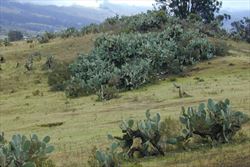
infestation of the spiny form of this species in Hawaii (Photo: Forest and Kim Starr, USGS)

habit of the spiny form of this species (Photo: Forest and Kim Starr, USGS)
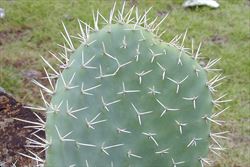
close-up of the spines on a stem segment of the spiny form of this species (Photo: Forest and Kim Starr, USGS)
Scientific Name
Opuntia ficus-indica (L.) Mill.
Synonyms
Cactus ficus-indica L.
Opuntia megacantha Salm-Dyck
Opuntia paraguayensis K. Schum.
Opuntis vulgaris Mill.
Family
Cactaceae
Common Names
Barbary fig, cactus pear, Indian fig, Indian fig prickly pear, Indian-fig, mission cactus, mission prickly pear, mission pricklypear, panini, prickly pear, prickly pear cactus, prickly-pear, pricklypear cactus, smooth mountain prickly pear, smooth prickly pear, spineless cactus, sweet prickly pear, sweet pricklypear, tuberous prickly pear, tuna cactus
Origin
The origin of this species is somewhat obscure, largely because it has been cultivated since ancient times for its edible fruit, but it is thought to have originated in Mexico.
Naturalised Distribution
Naturalised in south-eastern Queensland, in some inland parts of New South Wales, in Victoria and in south-eastern and eastern South Australia. However, Indian fig (Opuntia ficus-indica) is poorly collected and its distribution may be more widespread than herbarium records would indicate.
Also widely naturalised overseas in southern Europe, Africa, La Réunion, Asia, southern USA, the Caribbean, the Galápagos Islands and Hawaii.
Notes
Indian fig (Opuntia ficus-indica) is regarded as an environmental weed in Victoria and as a minor environmental weed in some other parts of Australia. It is grown for its edible fruit and sporadically escapes from cultivation, especially in inland semi-arid regions. However, it is not seen as such as serious problem as many of the other prickly pears (Opuntia spp.).
The plants that have become naturalised in Australia are generally spineless, however a spiny form of the species has become naturalised in other parts of the world. This spiny form is probably more invasive as it is usually not eaten by livestock and other animals. In Australia, Indian fig (Opuntia ficus-indica) is also controlled by insects that were introduced to control other prickly pears (Opuntia spp.), including prickly pear cochineal (Dactylopius opuntiae) and cactoblastis moth (Cactoblastis cactorum).
In South Africa and Ethiopia, Indian fig (Opuntia ficus-indica) is viewed as both a blessing and a curse. It is invasive in these countries but it also plays a crucial role in sustaining humans and livestock during drought and famine. In the Tigray region, in northern Ethiopia, large populations of Indian fig (Opuntia ficus-indica) were deliberately planted for this purpose. However, it has spread from these plantings and it is estimated to cover about 360 000 hectares. About two thirds of these infestations consist of spiny plants, and in areas where it is strongly invasive control measures may become necessary to limit its impact.
The spiny form of Indian fig (Opuntia ficus-indica) was also becoming so invasive in Hawaii, until a biocontrol campaign was instigated to manage it.

